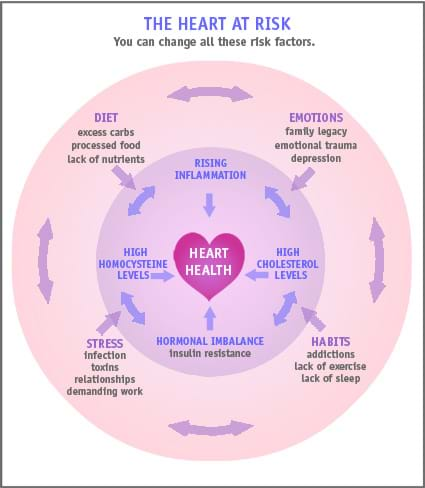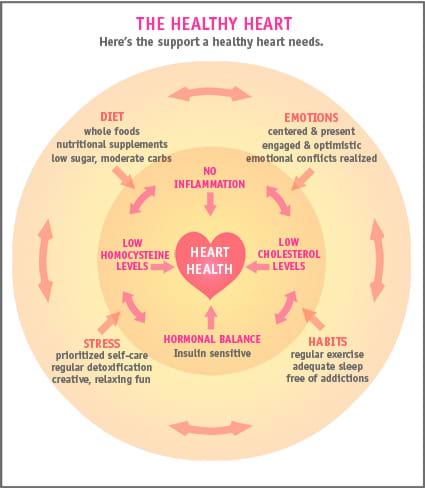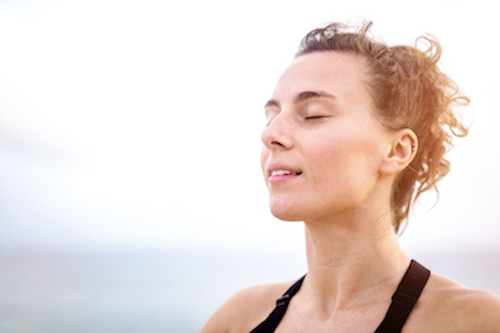Can yoga really regulate blood pressure? It may surprise you, but the answer is yes.
At least 32 million women in the U.S. have high blood pressure or hypertension. Lots of factors contribute to high blood pressure — diet, weight, lifestyle choices and stress, among others. And that’s where yoga comes in.
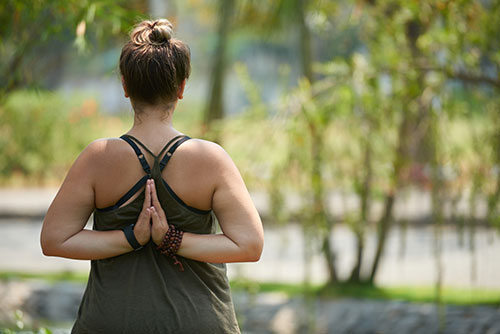
Yoga can reduce stress, and when stress is subtracted from the hypertension equation, blood pressure goes down.
Still, when it comes to high blood pressure (HBP) some styles and postures should be avoided or modified. With the information below, you can safely let the practice of yoga work for you to reduce tension, stress and, yes, blood pressure too.
What yoga should you avoid with high blood pressure?
If you have hypertension, you want to build a yoga practice that has positive effects on your blood pressure. Classes that are heated, extremely rigorous or focus on cardiovascular conditioning raise internal temperature, heart rate and blood pressure.Instead of pushing yourself, opt for slower paced vinyasa, hatha, restorative oryin-style yoga classes. Daily meditation can also lead to stress reduction and blood pressure modulation.
Breathwork (Pranayama) that creates a lot of heat (like Breath of Fire)or has you hold your breath is also not advised. You want your breathing to always be smooth, steady and evenly paced. The moment it gets heavy or choppy, stop what you are doing and rest until you have reset your rhythm.
The following poses should be avoided or modified. You’ll find helpful modifications in the next section.
- Difficult arm balances. Arm balances can be fun and challenging but, if you’re pushed to overexertion, frustration or strain, skip these poses.
- Inversions are risky if you have HBP. When your head is below your heart, blood rushes in and causes extra pressure on the brain, blood vessels and heart. This can increase the risk of stroke so avoid inversions such as Headstand, Shoulder Stand, Forearm Stand, and Handstand.
- Legs-Up-The-Wall (Viparita Karani) is debatable. One camp advises against it because your legs are inverted at a 90° angle up from the heart. The other camp says it’s okay because your head and heart are in the same line. Additionally, the pose is inherently relaxing, restorative and reduces stress. Just give it a miss if you have any doubts if it’s right for you or check with your own healthcare practitioner.
- Forward folds. Avoid or modify shapes where your head might dip below your heart.
- Advanced or deep backbends can raise your heart rate. If you feel strain in the chest, mind or breath, refrain from these altogether. If you feel they constrict your breathing omit these backbends: Bow, Active Bridge, Wheel, a deep Camel, and even Upward Facing Dog.
- Some schools of thought advise against raising the arms overhead if you have high blood pressure. As the arms rise, the heart works harder to circulate blood upward.
How to modify yoga poses for healthy blood pressure
I encourage you to observe the effects certain poses have on your body, mind and energy. After all, part of yoga is self-study (Svadhyaya). If you’re at higher risk for blood pressure issues, a few modifications can make all the difference.
Downward Dog modifications
Downward Dog at a wall
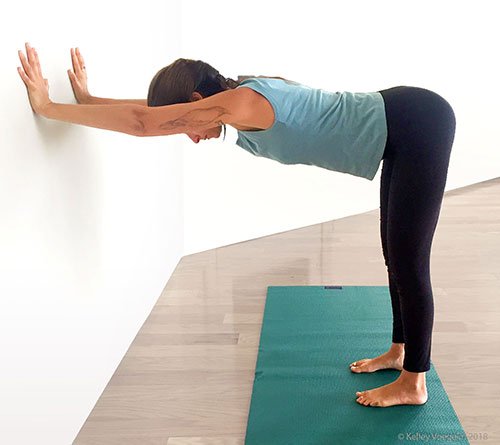
Take the inversion out of the pose and elevate your upper body. With your arms shoulder width, press your palms against a wall and take a step back to extend your arms. Let your head hover between the upper arms in line with your spine and chest. Press into the wall with your hands, and down into the floor with your legs and feet. Tilt your tailbone down and breathe here for about a minute and then slowly stand tall.
Downward Dog with support
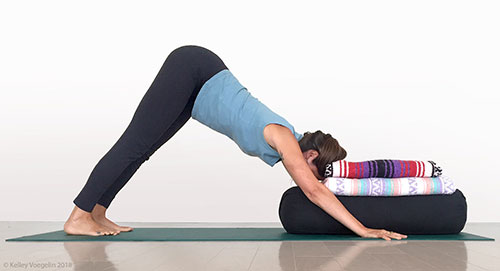
Place a bolster or a stack of folded blankets in front of you while you’re on hands and knees. Invert your hips up and back, extend your legs and arms, and spread palms and feet. Rest your head (between the forehead and crown) on the props in front of you. Make sure your head is gently touching down on the support with your neck long, spacious, and not crunched. This might mean that you add or subtract blankets.Breathe here for 30-60 seconds and then release to hands and knees, or continue into Child’s Pose.
Standing Pose modifications
If you have HBP, you’ll find that most standing poses are safe to do (Mountain,Tree, Lunges, the Warriors) as long as you don’t feel strain on your head or heart,and can maintain a smooth and rhythmic breath.
Folding forward
Modify shapes where your head might dip below your heart by elevating your head in line with your heart and your hands on blocks or shins instead of the ground or toes. Embrace blocks as tools to reduce force or strain when folding or balancing.Never overexert. Instead, find support, ease and — no matter what — steady breathing.
Raised arms
Modify any poses that ask you to lift your arms overhead. In shapes like Raised Hands Pose, Warrior 1, Tree, Triangle, Side Angle, High or Crescent Lunges, place your hands beside you, on hips or in prayer (Anjali Mudra). Be creative and use alternatives, anchoring to the other energetic qualities of these postures.
Wide-Legged Forward Bend (Prasarita Padottanasana)
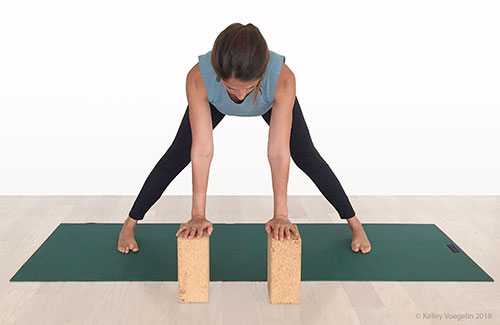
This pose is a beneficial standing pose that is easy to modify. This posture soothes the nervous system and heart, improves respiration and reduces HBP.
With your legs in a wide stance, step your feet about 4 ft. apart with their outer edges parallel to the short sides of the mat. Press your feet down firmly and lift your inner ankles and quadriceps. Extend your torso forward into a half fold from the pelvis instead of folding all the way down. Place your hands on blocks in line with your shoulders to keep your head, heart and spine parallel to the ground. Send the energy of your shins and thighs back. Create space in your side body and neck,breath gently and smoothly into your belly, spine, back and hamstrings.
Breathe here for 30-60 seconds, then, come out by placing hands on your hips, slowly lifting your upper body and stepping your feet together.
Backbend modifications
Supported Bridge Pose (Setu Bandha Sarvangasana)
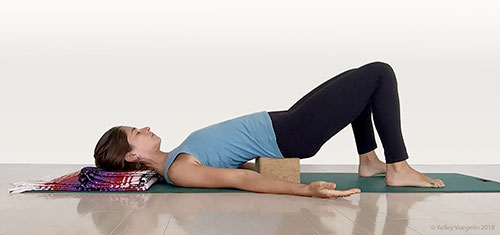
Do this beneficial backbend to nourish the kidneys and deeply calm the nervous system to reduce stress and tension. This pose also opens the chest and lungs, increasing circulation and respiration.
Sit in the middle of your mat, then lie on your back, bend your knees, press into your feet and lift your hips. Slide a block under your sacrum at its lowest height.Keep your knees directly above the ankles, or separate your feet slightly wider so the knees can touch at your mid line. If you need head or neck support, slide the fold of a blanket under the base of the skull.
You might close your eyes or use an eye pillow and then breathe evenly through your nose, relaxing in this pose for several minutes. When you feel ready, remove the block, roll to one side, and push slowly up to sitting.
Investigate all the ways you can achieve a safe and supported Bridge Pose to find the ones you like best.
Seated forward bend modifications
Seated forward bends are wonderful to energetically draw inward while still supporting the head just above the heart. This allows you to slow down, breathe quietly, and– you guessed it — regulate your blood pressure.
These cooling shapes calm activity in the mind, heart and nerves. Physically, they create elongated muscles and massage the internal organs. As tension clears from your muscles, it is also released from the blood vessels and heart.
Some forward bends that are safe for HBP are Child’s Pose over a bolster, Seated Forward Fold, Bound Angle, Head-to-Knee Pose and Seated Wide-Angle Pose. Rest your head on a bolster propped at an angle, stacked blocks or blankets, or even the edge of a chair.
Seated Wide-Angle Pose (Upavista Konasana)
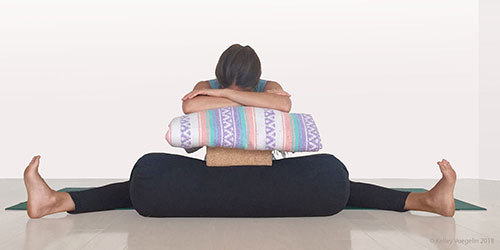
This pose is a beneficial forward bend that invites you to sit on the ground with the legs extended out wide. Sit at the edge of a folded blanket to lift the spine and soften the hips down from the pelvis. Press the soles of the feet outward, point your toes skyward and flex your ankles. Pin the thighs to the ground and lift the torso up and over the pelvis. Rest your head upon a bolster, blocks, or the edge of a chair.
Stay for several minutes and allow your breath to be slow, sweet and lengthened.When you feel ready to exit, slowly rise up and sit for a moment to take in the effects.
The best pose to relax your body and calm blood pressure
Hypertension is often made much worse with constant striving, worrying or agenda-making. What if you started to practice the art of surrender in some of your daily routines or yoga practice? Restful and restorative practices support this choice and invite inner space, ease and equilibrium.
Corpse Pose (Savasana)
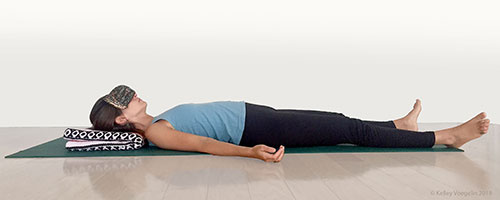
Never skip this pose, or underestimate its ability to help you unwind and let goof stress and tension. If you had to choose only one posture today, this is the one to lead you to surrender and renewal.
Lie on your back with the legs extended long, feet relaxed away from each other,and arms at your sides, palms face up. Place support under the head so that the neck is long and the throat isn’t opened back. If you feel tension in your head,recline your torso over a bolster.
You may want an eye pillow to block distractions. Keep the neck, throat and diaphragm soft and peaceful. Breathe slowly and quietly. Allow yourself to drift further into a relaxed state of being.
Stay for 5-15 minutes. Then carefully roll to one side, pause and help yourself up to sit.
Remember, if you have high blood pressure, check in with your healthcare provider and use your own intuition to choose the best yoga shapes for the safest and best practice possible. But don’t let hypertension hold you back from yoga because it can lower blood pressure, reduce stress, and guide you safely toward well being.
 |
Find out more yoga poses to release stress, plus other tips for a restorative yoga practice. |
https://www.fda.gov/forconsumers/byaudience/forwomen/ucm118529.htm
https://www.heart.org/en/health-topics/high-blood-pressure/why-high-blood-pressure-is-a-silent-killer/high-blood-pressure-and-women








